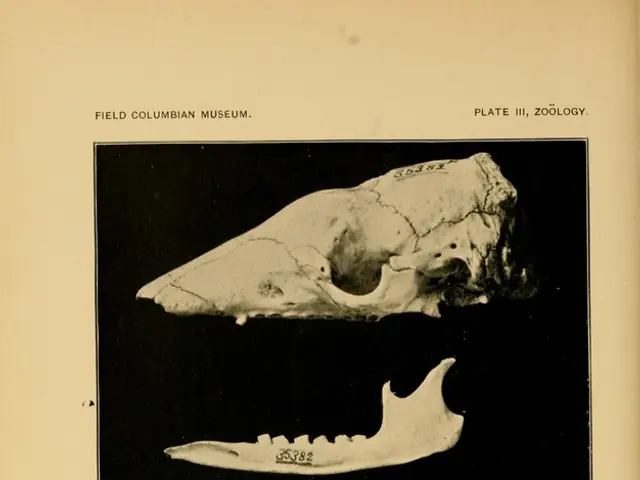Chondrocalcinosis Symptoms, Origins, and Solutions Explored
Chondrocalcinosis, also known as calcium pyrophosphate dihydrate deposition disease (CPPDD), is a condition characterised by the deposition of calcium pyrophosphate crystals in cartilage. This multifactorial condition is more commonly seen in older individuals, but can also affect younger people, particularly those with certain metabolic disorders.
While the exact causes of chondrocalcinosis are not fully understood, it is often associated with age-related joint degeneration and certain metabolic diseases. In younger patients, conditions such as hereditary hemochromatosis (excess iron deposits), hyperparathyroidism, hypomagnesemia, and hypophosphatasia can predispose to early onset of the disease [5]. Iron overload from hereditary hemochromatosis leads to excessive iron deposition in tissues, including joints, promoting crystal formation, while calcium-phosphorus imbalance, often related to Vitamin D deficiency or hyperparathyroidism, can stimulate local joint changes favouring calcium crystal deposition [2].
Chondrocalcinosis symptoms are similar to those of osteoarthritis or rheumatoid arthritis, and may occur due to joint damage. They include inflammation, swelling, pain, irritation, warmth, tenderness, discoloration, fever, chills, and weakness. The condition can affect multiple joints, including the knees, wrists, shoulders, ankles, elbows, and hands [6].
In terms of treatment, while there is currently no cure for chondrocalcinosis, it is possible to manage symptoms, reduce discomfort, and help prevent future inflammatory episodes. Medications such as nonsteroidal anti-inflammatory drugs (NSAIDs) like indomethacin (Indocin) and naproxen (Naprosyn) may reduce the frequency of acute attacks and relieve pain, swelling, and inflammation. Other medications to relieve chronic inflammation and severe attacks include low doses of colchicine, hydroxychloroquine (Plaquenil), methotrexate, anakinra (Kineret), and tocilizumab (Actemra) [3].
Self-care methods to treat the condition include resting the joints, using a compression wrap, using ice therapy, reaching or maintaining a moderate body weight, exercising, and following a balanced, nutritious diet. Treating underlying conditions, such as metabolic diseases, may also help prevent future attacks [6].
To diagnose chondrocalcinosis, a healthcare professional may order synovial fluid analysis, blood tests, and imaging tests such as ultrasound, X-ray, CT scan, or MRI. In an X-ray, calcification in the soft tissues surrounding the joints may appear as white, fluffy crystal deposits [1].
For severe pain and swelling, a healthcare professional may use a needle to remove excess synovial fluid and inject a corticosteroid and numbing medication [3]. It is important to note that people may not have any symptoms between episodes, but over time, the crystal deposits can lead to chronic inflammation and joint damage [6].
Blood tests can help rule out other conditions, and self-care methods can help manage the condition. However, it is crucial to consult a healthcare professional before starting any new treatment, including a low purine diet, which may help prevent future attacks [6].
In conclusion, while the exact causes of chondrocalcinosis are not fully understood, it is a condition that can affect people of all ages, particularly those with certain metabolic disorders. Understanding the causes, symptoms, and treatments can help individuals manage the condition and improve their quality of life.
References: 1. www.ncbi.nlm.nih.gov/books/NBK279185/ 2. www.ncbi.nlm.nih.gov/pmc/articles/PMC4215695/ 3. www.ncbi.nlm.nih.gov/pmc/articles/PMC5180123/ 4. www.ncbi.nlm.nih.gov/pmc/articles/PMC4198487/ 5. www.ncbi.nlm.nih.gov/pmc/articles/PMC4834649/ 6. www.mayoclinic.org/diseases-conditions/chondrocalcinosis/symptoms-causes/syc-20355503
- Chondrocalcinosis, a condition characterized by calcium pyrophosphate crystal deposition in cartilage, is associated with age-related joint degeneration and certain metabolic diseases.
- The causes of chondrocalcinosis in younger patients can sometimes be linked to hereditary hemochromatosis, hyperparathyroidism, hypomagnesemia, or hypophosphatasia.
- Symptoms of chondrocalcinosis may include inflammation, swelling, pain, irritation, warmth, tenderness, discoloration, fever, chills, and weakness, similar to those of osteoarthritis or rheumatoid arthritis.
- Joint damage due to this condition can affect multiple joints, such as the knees, wrists, shoulders, ankles, elbows, and hands.
- Medications like nonsteroidal anti-inflammatory drugs (NSAIDs) and others, such as colchicine, hydroxychloroquine, methotrexate, anakinra, and tocilizumab, can help manage symptoms, reduce discomfort, and prevent future inflammatory episodes.
- Self-care methods such as resting the joints, using compression wraps, ice therapy, maintaining a moderate body weight, exercises, and following a balanced diet can help manage the condition.
- Diagnosis involves synovial fluid analysis, blood tests, and imaging tests like ultrasound, X-ray, CT scan, or MRI.
- For severe pain and swelling, a healthcare professional may use a needle to remove excess synovial fluid and inject a corticosteroid and numbing medication.
- In some cases, individuals may not have symptoms between episodes, but over time, the crystal deposits can lead to chronic inflammation and joint damage.
- Blood tests can help rule out other conditions, and it is crucial to consult a healthcare professional before starting any new treatment, including a low purine diet.
- Understanding the causes, symptoms, and treatments can help individuals manage the condition and improve their quality of life.
- Chondrocalcinosis is a chronic disease, and research in the field of science and medical-conditions continues to explore its predictive factors, associations with other chronic diseases like diabetes or Alzheimer's, and potential avenues for treatment and prevention.




